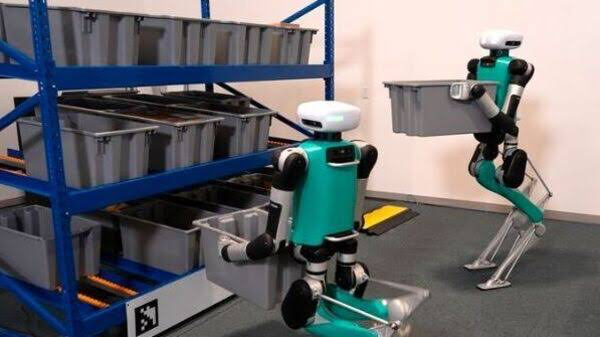Amazon’s Experiment with Digit: A Robot that Walks and Grasps.

Amazon is testing a new type of robot in its US warehouses, in an effort to improve its efficiency and customer service. The robot is called Digit, and it has a humanoid shape, with arms and legs that can move, grasp, and handle items like a human.
Amazon said the trial was about “freeing employees up to better deliver for our customers”. It said Digit could help with tasks that require mobility and manipulation, such as moving packages, containers, customer orders, and objects.

But not everyone is happy with Amazon’s automation. A union said Amazon had “been treating their workers like robots for years”. It said Amazon’s automation was a “head-first race to job losses” and that hundreds of jobs had already disappeared to it in fulfillment centers.

Amazon’s Robotics Systems: Creating or Destroying Jobs?
As the announcement was made, Amazon said its robotics systems had in fact helped create “hundreds of thousands of new jobs” within its operations. It said it had created 700 categories of new job types, in skilled roles, that didn’t exist within the company beforehand.

Amazon Robotics’ chief technologist, Tye Brady, told reporters at a media briefing in Seattle that people were “irreplaceable”, and disputed the suggestion that the company could have fully-automated warehouses in the future.
“There’s not any part of me that thinks that would ever be a reality,” he said. “People are so central to the fulfillment process; the ability to think at a higher level, the ability to diagnose problems”.
Digit: A Robot with Legs and Arms
Rather than using wheels to move, Digit walks on two legs. It also has arms that can pick up and move packages, containers, customer orders, and objects. Scott Dresser of Amazon Robotics told the BBC this allowed it to “deal with steps and stairs or places in our facility where we need to move up and down”.

But he said the robot was a prototype and the trial was about seeing whether it could work safely with human employees. “It’s an experiment that we’re running to learn a little bit more about how we can use mobile robots and manipulators in our environment here at Amazon,” he said.
Mr Dresser suggested that the fears over human jobs being replaced didn’t match what had happened at Amazon. “Our experience has been these new technologies actually create jobs, they allow us to grow and expand. And we’ve seen multiple examples of this through the robots that we have today. They don’t always run unfortunately and we need people to repair them,” he said.
Amazon’s Automation Journey: From Drones to Giant Arms
Amazon has ramped up its use of robots in recent years, as pressure has grown to cut costs. Last year it announced it was trialing a giant robotic arm that can pick up items. It already uses wheeled robots to move goods around its warehouses, and it has started using drones for delivery in two US states.
Amazon’s experiment with Digit is another step in its automation journey. But will it lead to more efficiency or more job losses? And will it change the way we interact with robots? Only time will tell. ⏳
Kindly leave your opinion in the comment section below 📝






